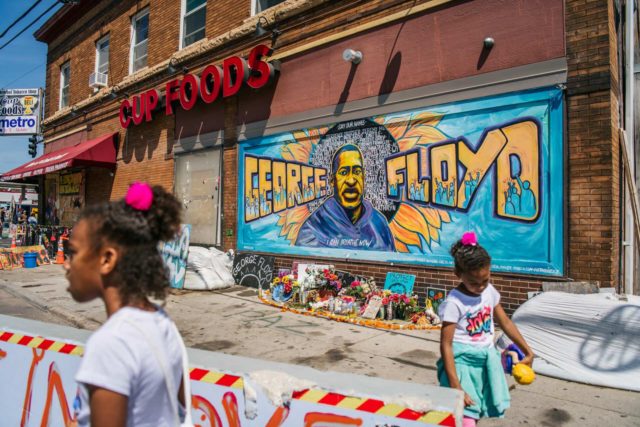
Report: Minneapolis failed to follow emergency protocols during protests, riots in 2020 Jordan and Royal Pacheco learn of George Floyd's murder at the intersection of 38th Street and Chicago Avenue. (Brandon Bell/Getty Images/TNS)
Mayor Jacob Frey failed to implement the city’s emergency protocols when responding to protests and riots that erupted across Minneapolis after George Floyd’s murder in the 10-day period starting May 25, 2020, according to a long-anticipated report given to City Council members Tuesday.
The “After Action Review” described a breakdown of communication inside the Minneapolis government during the chaotic unrest. With little guidance from leadership, first-responders traveled blindly into dangerous situations, while emergency operators fielded a heavy volume of emotional and increasingly threatening or obscene calls. Neighbors and business owners, feeling abandoned by their government, banded together to protect themselves.
Meanwhile, the poor communication, exacerbated by frustration with competency of command staff, resulted in an uneven police response that officers throughout the ranks agreed “did not go well.”
“There was a vast, vast void in consistent rules of engagement and control” regarding use of chemical munitions and less-lethal rounds, Chad McGinty, one of the researchers, told council members.
Floyd’s death in May of 2020 prompted protests in Minneapolis and across the nation, renewing a debate about police use of force. The Twin Cities also experienced looting and arson, with more than 1,500 businesses reporting an estimated $500 million in damages. At least two deaths were reported during the chaos.
The police’s use of force has led to lawsuits from the public and journalists who were injured during the aftermath, and city and state officials have publicly traded barbs over who was responsible for problems with the response.
McGinty offered the first insights into the report, conducted by Maryland risk management firm Hillard Heintze, which was released to the public in full after the presentation. To complete the report, researchers conducted interviews with 90 government workers and community members, reviewed dozens of hours of body-camera footage and analyzed 2,400 documents.
The report found that the Mayor’s office did not ensure the appropriate implementation of the city’s emergency response plan, in contrast to the well-coordinated response to prior catastrophes like the I-35W bridge collapse in 2007.
Instead of directing response from a command post, leadership for the Minneapolis Fire Department made individual calls on how to respond to fires from the streets. Some fire fighters spent 24-hour shifts fighting fires without rest. Others watched fires blazing from their stations, hamstrung from engaging by a bizarre response strategy they did not understand.
Many of the police officers interviewed for the report blamed a breakdown in competent command staff for the poor response, the report found, stating an overwhelming “lack of confidence in and perceived capability of MPD leadership’s decision making.”
“The civil unrest exacerbated these feelings when officers and field commanders desperately sought information, guidance and approvals for tactical actions and found those calls went unanswered or delayed,” the report stated. “This often led to increased risk and angst among the personnel in the field.”
The report noted that “despite our best efforts and numerous requests, directly and through identified sources, we found few line officers and community or activist groups willing to speak with us directly.” The 30 hours of body camera footage documented “the extent of lawlessness occurring in some circumstances under the guise of a peaceful protests,” such as fires and projectiles thrown at officers.
However, the report said, “The footage clearly revealed in some circumstances the lack of MPD command oversight, clear objectives, coordinated crowd-control measures and accountability for the deployment of less-lethal munitions.”
At the time of the unrest, the MPD lacked training on crowd control and handling protesters because a planned 2020 session was canceled during the COVID-19 pandemic. The report also noted that officers were under-equipped, wearing only a helmet and carrying a baton with their daily uniform.
“We commend the first-line supervisors stepping up to bring some level of organization to the police response, but we question their oversight of officers deploying less-lethal munitions under their control. Further, we note that the next level of command did not appear to be present or provide guidance or instruction to the supervisors on the street.”
Council Member Jason Chavez, whose ward includes part of the intersection where officers pinned Floyd and swaths of Lake Street that were heavily damaged, said he met Tuesday morning with Council Vice President Linea Palmisano and the city coordinator and they plan to provide quarterly updates on efforts to implement the report’s recommendations. “There is trauma. There is pain, and a lot of questions about what we will do next,” Chavez said. He added: “What we do next is what’s going to matter at this point forward.”
___
© 2022 StarTribune Distributed by Tribune Content Agency, LLC




